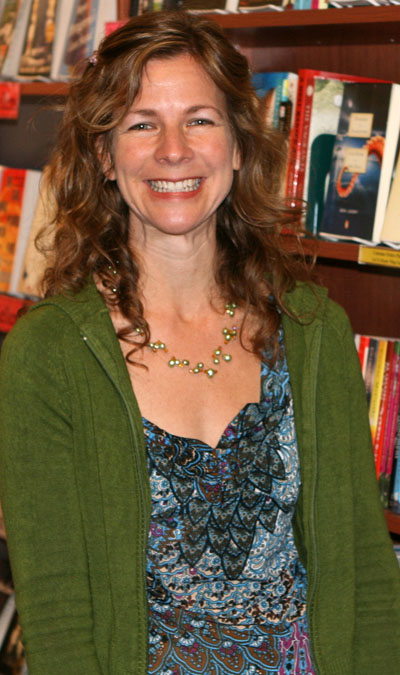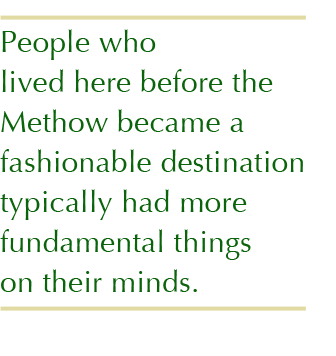home | internet service | web design | business directory | bulletin board | advertise | events calendar | contact | weather | cams

|
Fashionable Destination  Anthropologist Julie Tate Libby, owner of Trail's End Books, has studied "amenity migrant" effects on the Methow. - Photo by Solveig Torvik Anthropologist Julie Tate Libby, owner of Trail's End Books, has studied "amenity migrant" effects on the Methow. - Photo by Solveig Torvik“Amenity migrants” is the term used by anthropologists such as Julie Tate Libby of Winthrop to describe the influx of newcomers who have moved to the Methow Valley in recent years and, in the process, markedly changed its character. Such transformations by amenity migrants of rural areas that had been depopulated or fallen into poverty is a familiar story in the American West, as is the flight of urban people to attractive rural areas such as the Methow that are perceived as naturally “amenity rich.” “Quality of life” issues - not wars, disasters or economic pressures - propel these latter-day migrants to settle in places such as the Methow, says Tate Libby. As she recently told a Methow Conservancy class, “These areas are being valued on how you view the land.” Tate Libby, 34, is an Oregon native who moved to Carlton while in junior high school and graduated from Liberty Bell High School in 1995. She fell into her line of work as the result of a church mission trip to India when she was 17. “I came back a born-again anthropologist,” laughs the mother of two. She holds a doctorate in anthropology from the University of Otago in New Zealand, where she specialized in the effects of tourism on rural communities, and a master’s degree from Pacific Lutheran University. She’s a part-time instructor in anthropology and sociology at Wenatchee Valley Community College in Omak. She brings a unique perspective on the effects of amenity migrants on communities. She’s an academic who grew up in an amenity migrant destination, married Ken Libby - a man with deep family roots in the valley - and wrote an analysis of amenity migration in the Methow for her master’s thesis. She smiles at the common valley tendency to engage in a certain level of “myth-making” about the special wonders of life in the Methow. It reminds her of the philosopher Voltaire going about in the French countryside exclaiming: “This is the best of all possible worlds!” she says. “It’s not perfect here,” she reminds, though it’s true that among its many charms is that “You can go out your door and see a cougar.” Tate Libby looks at the Methow not only through the lens of someone who has seen the effects on her Liberty Bell classmates of economic changes wrought by the influx of wealthier newcomers. She’s versed in the broader social effects visited on small communities by amenity migration and tourism. And she has the hands-on perspective of a local business owner in a tourist-dependent economy; the couple owns Trail's End Bookstore and owned the Grubstake Restaurant in Winthrop for five years. She understands the perils of depending on an unpredictable, tourist-driven economy. She has seen how difficult it is for young people of her generation who are working for local wages to buy their own homes here. This too is a common theme played out across the American West, where long-time residents of rural communities such as the Methow find themselves working in low-paying service jobs while property prices escalate. “Amenity migration does make a place less affordable,” Tate Libby says.
People who lived here before the Methow became a fashionable destination for urbanites typically had more fundamental things on their minds: earning a living on the margins of a hard-scrabble economy, says Tate Libby. “It’s not that local people didn’t value these things,” she adds. The valley’s economy commonly is believed to be driven by tourism. But Tate Libby says she thinks the economic importance of amenity in-migration by well educated urban retirees and wealthy second home owners is overlooked. “I feel like it (amenity migration) is the major economy, especially when construction is included,” she argues, and adds that she considers amenity migration generally positive for the Methow. Still, Tate Libby says she’s concerned that “it leads to a two-tiered, soft class system,” adding that “nobody wants to say that it’s a class thing.” Newcomers often have no idea how most locals live their lives here. “They’re invisible,” she says. Moreover, she adds, “They don’t feel welcome in these institutions” that have sprung up as a result of well-meaning efforts by newcomers. Because she herself started out waiting tables as age 13, she understands that jobs in the valley’s service industry may make workers without other options feel resentful and socially inferior. “It made me feel subservient,” she says. It sometimes happens that amenity migrant communities sow the seeds of their own destruction because they become so populated and over-developed that they lose their appeal. But Tate Libby says she doesn’t feel that this necessarily will be the Methow’s fate. When she looks at the valley as an anthropologist views cycles of community growth and development, Tate Libby says she expects the time will come when the valley will be built out or when lack of water may halt its development. In the boom years before the recession, construction played an important part in the local economy. But if her prediction bears out, at some point construction likely will be less economically significant. What then? Perhaps the Methow’s economy may be boosted by serving its growing population of retirees, Tate Libby suggests, both amenity migrants and locals, who even now have unmet housing and care needs. 3/27/2012 Comments Best analysis I've read yet! Methow Conservancy deserves credit for providing a way for such excellent voices to be available to a wider audience. - Eric Burr Eric Burr Mazama This is a wonderful article. Julie is brilliant! Thanks for sharing the story. ~Georgina Tobiska Georgina Tobiska Twisp As a person interested in the flow of people to a place this is an interesting discussion. As a returning local I am an "amenity migrant" in the new vernacular. Historically we have found people coming to the Valley for many reasons free land, gold, and logging. Are these amenities? These reasons gave people an opportunity to better there lives in many ways. As the Valley changed through severe drought, no mining and a change in logging practices people were forced to move. We may see this happening again because many of the local folks who rely on more than tourism to survive will have to leave. Then what becomes of the remaining migrants. Who takes care of us? Carl Miller Winthrop It was a great pleasure to read Julie's well-considered analysis. My job brought me to the Valley in 1987, and took me away in 1999. My heart is still there. I return often, but seeing the changes brings me some discomfort. Thank you, Julie, for putting things in perspective! Connie Mehmel Cashmere
|
 But there are compensations. Such institutions as the Methow Conservancy, the Merc Playhouse, the Confluence and Winthrop art galleries likely would not exist if it weren’t for the presence of the newcomers, she says. A look at who’s volunteering on boards or giving financial support to the valley’s numerous culturally and socially enriching non-profit entities shows “It’s the people who’ve just moved here.” They’ve brought in the resources, skills, and the time to enhance, or at any rate change, the culture of the community.
But there are compensations. Such institutions as the Methow Conservancy, the Merc Playhouse, the Confluence and Winthrop art galleries likely would not exist if it weren’t for the presence of the newcomers, she says. A look at who’s volunteering on boards or giving financial support to the valley’s numerous culturally and socially enriching non-profit entities shows “It’s the people who’ve just moved here.” They’ve brought in the resources, skills, and the time to enhance, or at any rate change, the culture of the community.